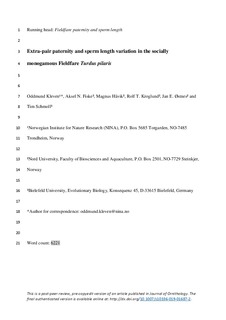Extra‑pair paternity and sperm length variation in the socially monogamous Fieldfare Turdus pilaris
Kleven, Oddmund; Fiske, Aksel N.; Håvik, Magnus; Kroglund, Rolf Terje; Østnes, Jan Eivind; Schmoll, Tim
Peer reviewed, Journal article
Accepted version

Åpne
Permanent lenke
http://hdl.handle.net/11250/2609432Utgivelsesdato
2019Metadata
Vis full innførselSamlinger
- Scientific publications [1392]
Originalversjon
10.1007/s10336-019-01687-2Sammendrag
Basic knowledge about the genetic mating system is lacking for the great majority of the approximately 10,000 extant bird species. Filling this knowledge gap is not only critical for a comprehensive understanding of the reproductive ecology of each particular species, but also for increasing the power of comparative approaches to uncover and explain interspecific patterns of variation in avian reproductive traits. Using six polymorphic microsatellite markers, we here present the first parentage study in the socially monogamous Fieldfare Turdus pilaris. In parallel, we also examine variation in sperm morphology and relationships between sperm traits and paternity loss of social males. Across two study years, extra-pair paternity was detected in 46.4% (95% CI: 28.9–64.9%) of 28 broods, and on average 27.6% (95% CI: 16.8–41.9%) of nestlings per brood were extra-pair offspring in a population in central Norway. These observed extra-pair paternity rates fall within the range of reported estimates of extra-pair paternity for four congeneric Turdus species (between 36 and 65% of broods and 27 and 46% of nestlings). Sperm total length was 87.0 ± 2.9 (SD) μm (range 79.7‒96.8 μm) and 59.3% (95% CI: 37.1–73.3%) of the total phenotypic variation in sperm total length was explained by differences between sperm samples collected from 17 different males. The among-sample coefficient of variation in mean sperm total length was 2.70% (95% CI: 1.99–3.17%). We found no evidence for effects of sperm total length or relative midpiece length on loss of paternity among broods of 13 males.